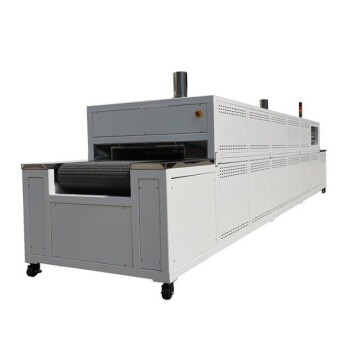In modern dentistry, a dental furnace is a specialized, high-temperature oven essential for fabricating ceramic dental restorations. It uses precisely controlled heat, and sometimes pressure, to transform pre-formed or milled ceramic materials into their final, hardened state, ready for placement in a patient's mouth. This process is used to create durable and aesthetic crowns, bridges, veneers, inlays, and onlays.
A dental furnace is not merely a heating device; it is the critical final step in the restorative workflow that determines the ultimate strength, fit, and esthetics of a ceramic restoration. It transforms a chalky, fragile pre-sintered material into a robust, tooth-like structure.
The Core Function: From Fragile Form to Final Prosthesis
The primary role of the furnace is to execute a carefully programmed heating cycle that fundamentally changes the physical properties of the dental ceramic. This process is generally known as firing or sintering.
The Sintering Process
Sintering is the process of compacting and forming a solid mass of material by heat without melting it to the point of liquefaction.
During sintering, the ceramic particles fuse together, eliminating the pores between them. This densification is what gives the final restoration its significant strength and translucency.
Achieving Strength and Aesthetics
A milled zirconia crown, before it enters the furnace, is in a soft, chalk-like "green state" and can be broken with your fingers.
The furnace's high-temperature cycle (often exceeding 1500°C for zirconia) initiates the sintering process, shrinking the restoration by about 20-25% and transforming it into one of the strongest materials in dentistry.
Beyond Sintering: Glazing and Staining
Many furnaces also perform lower-temperature cycles for glazing and staining.
A glaze is a thin layer of glass fused to the surface of the restoration, giving it a smooth, lustrous, and natural appearance. Stains are used to add custom characterization, mimicking the natural look of the patient's adjacent teeth.
Understanding the Key Furnace Types
While they all use heat, dental furnaces are often specialized for different materials and processes. Understanding the types clarifies their role in the dental lab or clinic.
Sintering Furnaces
These are the highest-temperature units, designed specifically for materials like zirconia. Their main job is to take the restoration from its pre-sintered state to its final, fully dense form.
Pressing Furnaces
Used for "pressable" ceramics like lithium disilicate, these furnaces use a combination of heat and air pressure. The heat softens a ceramic ingot, and a plunger presses the molten ceramic into a mold, creating a highly accurate restoration.
Ceramic Firing Furnaces
These are versatile, all-purpose ovens used for traditional porcelain work. They handle lower-temperature firing cycles for layering porcelain, as well as the final staining and glazing cycles for many types of restorations.
Common Pitfalls and Considerations
Investing in and operating a dental furnace requires an understanding of its limitations and maintenance needs. Missteps here can directly lead to failed restorations.
Material Specificity is Crucial
A furnace designed for porcelain cannot reach the extreme temperatures required to properly sinter zirconia. Using the wrong furnace or program will result in a weak restoration that is likely to fail in the mouth.
Calibration Determines Success
An improperly calibrated furnace—one that does not reach or hold the exact specified temperature—is a primary cause of restoration failure. This can lead to fractures, poor fit, or incorrect shades, wasting significant time and money.
The Trade-off Between Speed and Quality
Many modern furnaces offer "speed" or "fast" sintering cycles. While these drastically reduce production time, they can sometimes compromise the final esthetic properties, such as translucency, compared to a slower, traditional cycle.
How to Apply This to Your Practice
Your choice and use of a dental furnace should directly align with the types of restorations you plan to produce.
- If your primary focus is high-strength zirconia restorations: You require a dedicated sintering furnace capable of consistently reaching and holding temperatures above 1500°C.
- If your primary focus is highly esthetic pressable ceramics (e.g., veneers): A pressing furnace that offers precise control over temperature, time, and pressure is non-negotiable.
- If you are a full-service lab or "in-office" milling clinic: A combination of furnaces, or a single versatile unit capable of both high-temp sintering and lower-temp glazing, provides the most flexibility.
Ultimately, the dental furnace is the linchpin that transforms a digital design into a clinically successful and durable ceramic restoration.
Summary Table:
| Furnace Type | Primary Function | Key Materials | Typical Temperature Range |
|---|---|---|---|
| Sintering Furnace | Densifies pre-sintered ceramics for strength | Zirconia | > 1500°C |
| Pressing Furnace | Heats and presses ceramic into a mold | Lithium Disilicate | High Temp + Pressure |
| Ceramic Firing Furnace | Layers porcelain, applies stains and glaze | Traditional Porcelain | Lower Temperatures |
Achieve Unmatched Precision and Aesthetics in Your Dental Lab
Leveraging exceptional R&D and in-house manufacturing, KINTEK provides dental laboratories and clinics with advanced high-temperature furnace solutions. Our product line, including Muffle, Tube, and Vacuum & Atmosphere Furnaces, is complemented by our strong deep customization capability to precisely meet your unique workflow requirements for sintering, pressing, and glazing.
Contact KINTEK today to discuss how our furnaces can enhance the strength, fit, and beauty of your ceramic restorations.
Related Products
- Dental Porcelain Zirconia Sintering Ceramic Vacuum Press Furnace
- Chairside Dental Porcelain Zirconia Sintering Furnace with Transformer for Ceramic Restorations
- High Temperature Muffle Oven Furnace for Laboratory Debinding and Pre Sintering
- 1700℃ Controlled Inert Nitrogen Atmosphere Furnace
- Laboratory Muffle Oven Furnace with Bottom Lifting
People Also Ask
- What is a dental sintering furnace and what is its purpose? Achieve High-Strength Dental Restorations
- What is the sintering process in dentistry? Unlock the Strength of Zirconia Restorations
- Why is precise temperature control important in dental sintering furnaces? Ensure Strong, Aesthetic Dental Restorations
- How has the sintering process innovated dental zirconia applications? Boost Strength, Precision, and Efficiency
- What are some common mistakes when operating dental sintering furnaces? Avoid Costly Errors for Perfect Zirconia Restorations



















